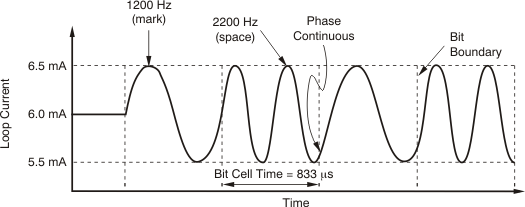JAJSEF2D June 2013 – December 2021 DAC7760 , DAC8760
PRODUCTION DATA
- 1 特長
- 2 アプリケーション
- 3 概要
- 4 Revision History
- 5 Device Comparison Table
- 6 Pin Configuration and Functions
- 7 Specifications
- 8 Detailed Description
- 9 Application and Implementation
- 10Power Supply Recommendations
- 11Layout
- 12Device and Documentation Support
- 13Mechanical, Packaging, and Orderable Information
パッケージ・オプション
メカニカル・データ(パッケージ|ピン)
サーマルパッド・メカニカル・データ
発注情報
8.4.4.1 For 4-mA to 20-mA Mode
This method is limited to the case where the RANGE bits of Table 8-17 are programmed to the 4-mA to 20-mA range. Some applications require going beyond the 4-mA to 20-mA range. In those cases, see second method described in this section.
The external HART signal (ac voltage; 500 mVPP, 1200 Hz and 2200 Hz) can be capacitively coupled in through the HART-IN pin and transferred to a current that is superimposed on the 4-mA to 20-mA current output. The HART-IN pin has a typical input impedance of 35 kΩ that together with the input capacitor used to couple the external HART signal forms a filter to attenuate frequencies beyond the HART band-pass region. In addition to this filter, an external passive filter is recommended to complete the filtering requirements of the HART specifications. Figure 8-8 illustrates the output current versus time operation for a typical HART signal.

Table 8-11 specifies the performance of the HART-IN pin.
| PARAMETER | TEST CONDITIONS | MIN | TYP | MAX | UNIT |
|---|---|---|---|---|---|
| Input impedance | HART signal ac-coupled into pin | 35 | kΩ | ||
| Output current (peak-to-peak) | Input signal of 500 mV (peak-to-peak) | 0.9 | 1 | 1.1 | mA |